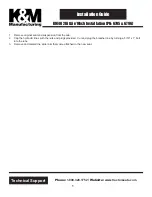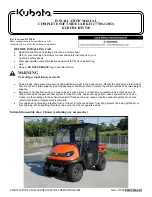
10
wheel
circumference
entered,
DaVinci
calculates
the
speed
and
distance
run.
For
a
correct
gear
indication
the
sensor
must
sense
the
REAR
wheel
speed.
Carry
out
the
following
installation
stages:
1.
Insert
the
sensor
into
the
hole
on
the
support
and
position
it
so
that
the
brake
disk
bolts
run
at
a
distance
of
about
1
mm.
from
the
sensor
tip.
In
most
cases
you
can
drill
the
support
of
the
rear
brake
caliper
and
fix
the
sensor
directly
without
the
supplied
bracket.*
2.
Lock
the
sensor
nuts
to
fix
it
to
the
support
.
Attention!
Never
tighten
the
nuts
too
much
to
avoid
“ironing
out”
the
sensor
and
damaging
it
irreparably.
3.
Fix
the
cable
by
means
of
plastic
clamps
so
that
it
is
never
tensioned
during
use.
4.
Connect
the
sensor
as
follows:
BROWN
=
+12V
key
switched
BLUE
=
Ground
BLACK
=
Instrument
speed
input.
5.
Turn
the
key
to
the
ignition
position.
6.
Check
the
sensor
operation:
every
time
a
bolt
passes
in
front
of
the
sensor,
the
yellow
LED
near
the
sensor
cable
output
must
turn
on.
If
this
does
not
happen,
slightly
put
the
sensor
close
to
the
bolt
head
of
the
bolt,
suggested
distance
1mm,
(the
bolts
must
be
made
of
ferrous
material
but
not
of
burnished
iron),
in
case
of
hexagon
socket
screws
position
the
sensor
with
a
little
offset
to
avoid
any
double
switching
brought
about
by
the
hole
in
the
head
(see
picture).
circonferenza
ruota
inseriti,
DaVinci
calcola
velocità
e
distanza
percorsa.
Per
una
corretta
indicazione
della
marcia
inserita
il
sensore
deve
rilevare
la
velocità
della
ruota
POSTERIORE.
Seguire
le
seguenti
fasi
d’installazione:
1.
Inserire
il
sensore
nell’apposito
foro
sul
supporto
e
posizionarlo
in
modo
che
i
bulloni
del
disco
freno
scorrano
ad
una
distanza
di
circa
1
mm.
dalla
testa
del
sensore.
Nella
maggior
parte
dei
casi
è
possibile
forare
il
supporto
della
pinza
‐
freno
posteriore
e
fissare
il
sensore
direttamente
senza
utilizzare
la
staffa
fornita.*
2.
Bloccare
i
dadi
del
sensore
in
modo
da
fissarlo
al
supporto.
Attenzione!
Non
bloccare
troppo
i
dadi
per
evitare
di
“stirare”
il
sensore
danneggiandolo
irreparabilmente.
3.
Fissare
il
cavo
con
fascette
in
modo
che
durante
l’uso
non
sia
mai
in
tensione.
4.
Collegare
il
sensore
come
indicato
di
seguito:
MARRONE
=
+12V
sotto
chiave
BLU
=
Massa
NERO
=
Ingresso
Velocità
dello
strumento.
5.
Ruotare
la
chiave
sulla
posizione
di
accensione.
6.
Verificare
il
funzionamento
del
sensore:
ogni
volta
che
un
bullone
passa
di
fronte
al
sensore
il
LED
giallo
vicino
all’uscita
cavo
del
sensore
si
deve
illuminare,
se
ciò
non
accade,
avvicinare
leggermente
il
sensore
alla
testa
del
bullone,
distanza
consigliata
1mm,
(i
bulloni
devono
essere
di
materiale
ferroso
ma
non
di
ferro
brunito),
in
presenza
di
bulloni
a
brugola
posizionare
il
sensore
leggermente
decentrato
per
evitare











































